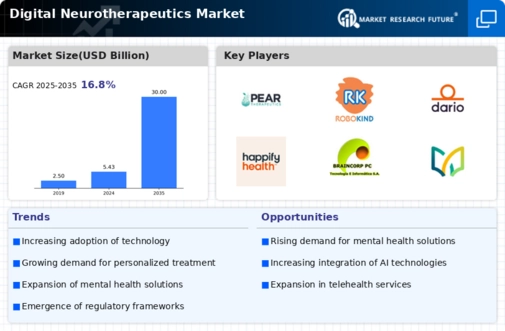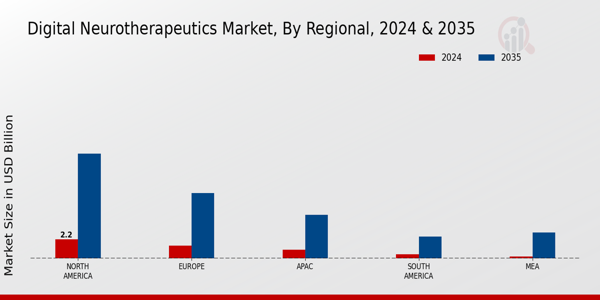Market Growth Projections
The Global Digital Neurotherapeutics Market Industry is poised for substantial growth, with projections indicating a market value of 5.43 USD Billion in 2024 and an anticipated increase to 30 USD Billion by 2035. This growth trajectory suggests a compound annual growth rate of 16.81% from 2025 to 2035. Factors contributing to this growth include the rising prevalence of neurological disorders, technological advancements, and increased investment in mental health solutions. As the market evolves, it is likely to attract new players and foster innovation, ultimately enhancing the range of digital therapeutic options available to patients and healthcare providers.
Regulatory Support and Frameworks
Regulatory support is a crucial driver for the Global Digital Neurotherapeutics Market Industry, as governments and regulatory bodies establish frameworks to ensure the safety and efficacy of digital therapeutic solutions. Initiatives aimed at streamlining the approval process for digital therapeutics are emerging, which encourages innovation and investment in the sector. For instance, the U.S. Food and Drug Administration has introduced guidelines for the evaluation of digital health technologies, which enhances confidence among developers and investors. This regulatory clarity is expected to foster a conducive environment for the growth of digital neurotherapeutics, potentially leading to a market valuation of 30 USD Billion by 2035.
Growing Acceptance of Digital Therapeutics
The Global Digital Neurotherapeutics Market Industry is experiencing a paradigm shift as healthcare providers and patients increasingly accept digital therapeutics as viable treatment options. This acceptance is driven by the proven effectiveness of digital interventions in managing various neurological conditions. Clinical studies have demonstrated that digital therapeutics can lead to improved patient outcomes, which is encouraging healthcare professionals to incorporate these solutions into their practice. Furthermore, patients appreciate the convenience and flexibility that digital therapies offer. This growing acceptance is likely to contribute to the market's expansion, with projections indicating a market value of 5.43 USD Billion in 2024 and a potential increase to 30 USD Billion by 2035.
Rising Prevalence of Neurological Disorders
The Global Digital Neurotherapeutics Market Industry is witnessing a surge in demand driven by the increasing prevalence of neurological disorders such as depression, anxiety, and epilepsy. As of 2024, the market is valued at 5.43 USD Billion, reflecting a growing recognition of the need for innovative treatment solutions. The World Health Organization reports that over 1 billion people globally suffer from mental health disorders, which underscores the urgency for effective neurotherapeutic interventions. This rising incidence is likely to propel the adoption of digital therapeutics, as they offer accessible and scalable treatment options that can be integrated into traditional healthcare frameworks.
Technological Advancements in Digital Health
Technological advancements play a pivotal role in shaping the Global Digital Neurotherapeutics Market Industry. Innovations in artificial intelligence, machine learning, and mobile health applications are enhancing the efficacy and personalization of neurotherapeutic solutions. For instance, platforms that utilize AI algorithms can analyze patient data to tailor interventions, thereby improving outcomes. The integration of wearable devices also allows for real-time monitoring of patients, which is crucial for conditions like epilepsy. As these technologies continue to evolve, they are expected to drive market growth, with projections indicating a market expansion to 30 USD Billion by 2035, reflecting a compound annual growth rate of 16.81% from 2025 to 2035.
Increased Investment in Mental Health Solutions
The Global Digital Neurotherapeutics Market Industry is benefiting from increased investment in mental health solutions by both public and private sectors. Governments worldwide are recognizing the economic burden of untreated mental health conditions and are allocating funds to develop and implement digital therapeutic solutions. For example, initiatives in various countries aim to integrate digital therapeutics into existing healthcare systems, thereby enhancing accessibility and affordability. This influx of capital is likely to stimulate innovation and expansion within the market, fostering a more robust ecosystem for digital neurotherapeutics. As a result, the market is expected to grow significantly, reaching 30 USD Billion by 2035.



















